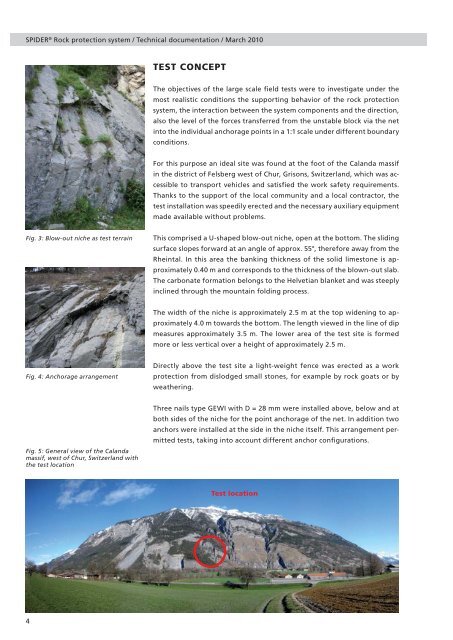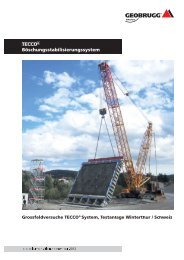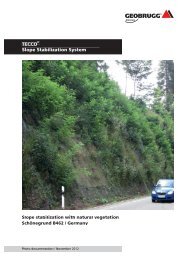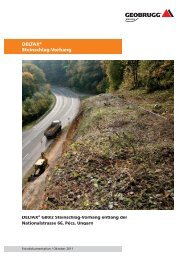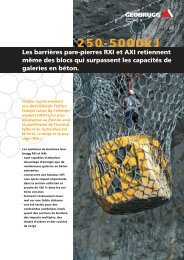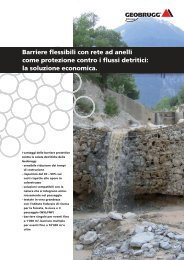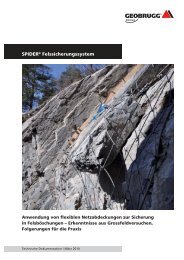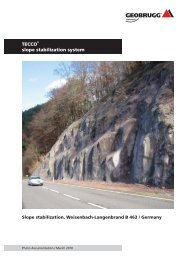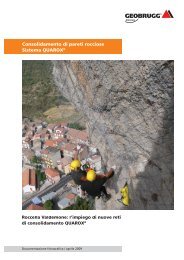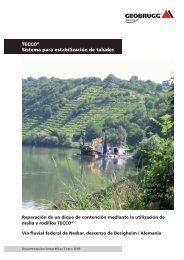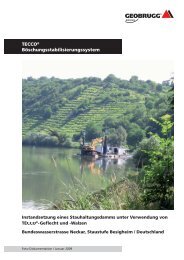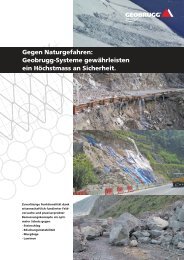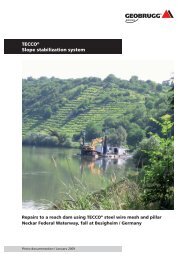SPIDER® Rock protection system - Geobrugg AG
SPIDER® Rock protection system - Geobrugg AG
SPIDER® Rock protection system - Geobrugg AG
You also want an ePaper? Increase the reach of your titles
YUMPU automatically turns print PDFs into web optimized ePapers that Google loves.
SPIDER ® <strong>Rock</strong> <strong>protection</strong> <strong>system</strong> / Technical documentation / March 2010<br />
Fig. 3: Blow-out niche as test terrain<br />
Fig. 4: Anchorage arrangement<br />
Fig. 5: General view of the Calanda<br />
massif, west of Chur, Switzerland with<br />
the test location<br />
4<br />
TEST CONCEPT<br />
The objectives of the large scale fi eld tests were to investigate under the<br />
most realistic conditions the supporting behavior of the rock <strong>protection</strong><br />
<strong>system</strong>, the interaction between the <strong>system</strong> components and the direction,<br />
also the level of the forces transferred from the unstable block via the net<br />
into the individual anchorage points in a 1:1 scale under different boundary<br />
conditions.<br />
For this purpose an ideal site was found at the foot of the Calanda massif<br />
in the district of Felsberg west of Chur, Grisons, Switzerland, which was accessible<br />
to transport vehicles and satisfi ed the work safety requirements.<br />
Thanks to the support of the local community and a local contractor, the<br />
test installation was speedily erected and the necessary auxiliary equipment<br />
made available without problems.<br />
This comprised a U-shaped blow-out niche, open at the bottom. The sliding<br />
surface slopes forward at an angle of approx. 55°, therefore away from the<br />
Rheintal. In this area the banking thickness of the solid limestone is approximately<br />
0.40 m and corresponds to the thickness of the blown-out slab.<br />
The carbonate formation belongs to the Helvetian blanket and was steeply<br />
inclined through the mountain folding process.<br />
The width of the niche is approximately 2.5 m at the top widening to approximately<br />
4.0 m towards the bottom. The length viewed in the line of dip<br />
measures approximately 3.5 m. The lower area of the test site is formed<br />
more or less vertical over a height of approximately 2.5 m.<br />
Directly above the test site a light-weight fence was erected as a work<br />
<strong>protection</strong> from dislodged small stones, for example by rock goats or by<br />
weathering.<br />
Three nails type GEWI with D = 28 mm were installed above, below and at<br />
both sides of the niche for the point anchorage of the net. In addition two<br />
anchors were installed at the side in the niche itself. This arrangement permitted<br />
tests, taking into account different anchor confi gurations.<br />
Test location


